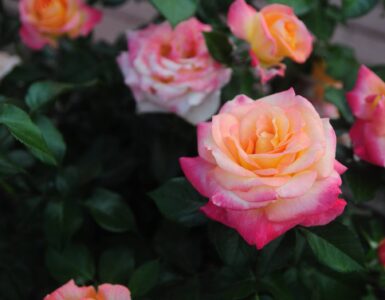That planter on your front porch or back patio isn’t just there to look welcoming and colorful. It can have some little known benefits, too.
Linda Brewer, from Tri City Nursery, shows some of the plants that not only look good, but have hidden benefits.
Two planters that are great examples of planters with benefits are:
The Fragrant Garden
Rose–‘Knock out’
Stevia
Lemon Thyme
Dianthus–‘Shining Star’
Rosemary
Lavender
The Medicine Chest Garden
Elderberry–‘Black Beauty’
Coreopsis–‘Jethro Tull’
Salvia–‘May Night’
Mother of Thyme and Red Flowered Creeping Thyme
Dianthus–‘Zing Rose’
These make a great planter, but there are several other plants and shrubs that have added benefits.
Shrubs:
Elderberry (Sambucus nigra) ‘Black Beauty’—called the medicine chest of the country people. The leaves act as an insecticide and protect fruit and vegetables from aphids and greenfly. The hardwood can be used to make musical instruments. A bunch of the flowers tied up in muslin and cooked with the berries creates a syrup for ice cream and fruit salads. The Romans used the berries to dye their hair. Infusions of elder flowers have been used to treat colds and flu by clearing the upper respiratory system. If you planted one by the house, it was thought to guard against evil spells and thunder. It is said that if you stand under it at midnight on midsummer night you will see the King of the Elves go by.
Rose—shrub rose—‘Knockout’—traditional symbol of Love and named ‘Queen of the Flowers.’
Used for scent in pot-pourri. Rose honey is used to soothe sore throats. Rose hip syrup, made from the hips of the dog rose are known to be twenty times richer in Vitamin C than oranges. Rose oil is used in perfume. Rose oil is complicated to make, but rose water is fairly easy.
To make Rose-water: Fill a saucepan with strongly scented red rose petals and cover with water. Bring to a boil. Turn off the heat, tightly cover and let cool. After cooling, strain. Save the resulting rose-water. If you simmer the rose-water with 4 tbs. of sugar, it will give off a lovely rose-scented fragrance.
Perennials: return every year
Lavender—the English lavenders (Munstead and Hidcote) have the strongest fragrance. A classic combination with roses in pot-pourri. Use to scent linens, clothes and body. A small bouquet at your bedside is said to be calming and will help you sleep.
Coreopsis ‘Jethro Tull’, Common name: tickseed—flowers and seeds used for dying wool. Produces reds, oranges and yellows.
Dianthus (varieties in pots include ‘Zing rose’ and ‘Shining Star’), also known as carnations or pinks. In medieval times they were also known as gillyflowers—the scent is similar to cloves. Symbol of marital love, fertility and fidelity. Used in pot-pourri and the oil is popular in perfumes. Fresh petals can be eaten in salads, pies and sandwiches.
Salvia ‘May Night’ (sage)—symbolizes domestic virtue. Has a strong flavor. Has the ability to make fatty foods more digestible so it is a good flavoring for pork, chicken, duck and goose. Cosmetically, it is good for the scalp, hair and complexion. If used as a face pack, it will help to close open pores, thus giving you smooth skin.
Herbs: tender, usually need to be replaced every year. Can be grown in pots indoors during the winter.
Stevia—leaves are a natural sweetener.
Thyme (varieties used in the pots include: lemon thyme, mother of thyme, red-flowered creeping thyme groundcover)—symbol of courage—in the Middle Ages, a sprig was given to knights by their ladies. Used for its antiseptic qualities. It contains thymol which is an ingredient in modern toothpastes and mouthwashes. Used in flavoring cream cheeses, meats and Italian foods. Aids in digestion. Dried sprigs hung in the closet keep moths away. Good in pot-pourri.
Rosemary—symbolizes remembrance, friendship and fidelity. The leaves of this plant are used. Cosmetically, it is good in shampoos and conditioners for the hair. A lotion, containing rosemary, dabbed under the eyes will reduce puffiness. In cooking, it has a strong flavor. It is best added at the beginning of cooking rather than at the end. It is a good flavoring for lamb and chicken.
For more information, you can contact Tri City Nursery in Kaysville at tricitynursery.com















Add comment